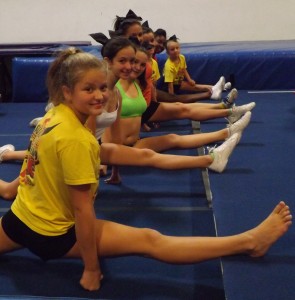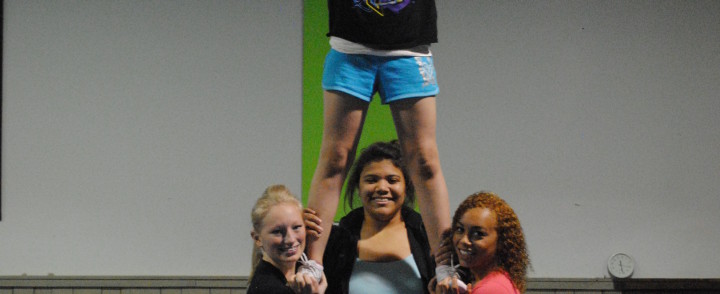Class Act: Get an “A+” in Throwing Specialty Classes and Clinics
 At Cheer Factor in Foxboro, Mass., specialty clinics are for athletes at the “top” of their game—literally. Inspired by a similar program at USA Gymnastics, Cheer Factor’s new “T.O.P. (Talent Opportunity Program)” has been a huge hit with athletes from its three locations, as well as area schools. Geared at Level 5 athletes (or those approaching Level 5 status), the T.O.P. clinic has become a coveted invite-only event.
At Cheer Factor in Foxboro, Mass., specialty clinics are for athletes at the “top” of their game—literally. Inspired by a similar program at USA Gymnastics, Cheer Factor’s new “T.O.P. (Talent Opportunity Program)” has been a huge hit with athletes from its three locations, as well as area schools. Geared at Level 5 athletes (or those approaching Level 5 status), the T.O.P. clinic has become a coveted invite-only event.
“Not only did it serve as a motivational tool and a great way to get all of our kids from different locations together, but it was also a way to start building our Level 5 program for next year,” shares Heather Kalnicki, head tumbling instructor. 32 of the 40 invited athletes attended, and the exclusive nature of the clinic inherently created demand for future offerings. “A lot of Level 3 and 4 athletes who are borderline know they’ll get invited when they’re ready,” adds Kalnicki.
Whether it’s an elite invite-only clinic, cheerlebrity master class or other type of specialty clinic, classes and clinics can be a win-win for both athletes and cheer professionals. For athletes, it’s a chance to break out of routine and focus on a specific area of improvement, while for gyms, it can be a viable source of revenue and means of attracting new athletes.
How It Works
Simply put, master classes and specialty clinics meet a specific need for athletes—such as honing in on a special area of interest or learning from a top professional from outside the gym. Depending on the nature of the class, classes can be ongoing or one-time only. For instance, at Columbia, SC-based Carolina Crossfire Cheer, ongoing classes range from back handspring clinics to stunting classes to “Fit and Flex” (focused on stretching and flexibility). “If you pick a skill that your athletes need work on and create a clinic or class, parents and cheerleaders are more likely to have a reason to participate,” says owner Angela Koenig.
In some instances, one-off clinics can spring from unexpected opportunities. That’s exactly how Lisa Murphy of Union Grove, WI-based Envy All-Stars ended up booking cheerlebrity Kiara Nowlin for a tumbling clinic. Murphy had inquired about hiring Nowlin as a choreographer and learned that Nowlin doesn’t do choreography, but instead travels to various gyms providing master classes. “My partners loved the idea and thought it would be great for us, being a new gym,” shares Murphy.
Planning + Profit
 According to Koenig, one-time classes and clinics can be especially profitable when properly planned. While ongoing classes are typically limited to a low student-to-instructor ratio, clinics can often accommodate more athletes; families may also be more willing to make a one-time investment than pay for a recurring class. “If you set a minimum number of students to be registered in order to host the clinic and if you charge the right amount, you can make more than [in] a standard class,” says Koenig, who says a typical three-hour clinic at her gym could cost $30 per participant.
According to Koenig, one-time classes and clinics can be especially profitable when properly planned. While ongoing classes are typically limited to a low student-to-instructor ratio, clinics can often accommodate more athletes; families may also be more willing to make a one-time investment than pay for a recurring class. “If you set a minimum number of students to be registered in order to host the clinic and if you charge the right amount, you can make more than [in] a standard class,” says Koenig, who says a typical three-hour clinic at her gym could cost $30 per participant.
In other cases, the end goal may not be profit-related, allowing for more flexibility with pricing. For the T.O.P. Clinic, Cheer Factor charged just $10/participant as the clinic was geared to be a feeder for the gym’s Level 5 program. “We didn’t want to make money—our goal was more motivating our athletes and getting all the Level Fives in our area together in one gym,” says Kalnicki.
Cheerlebrity and choreographer master classes can be a more substantial investment, as gyms are paying not only for the cache of the cheerlebrity but also for all of the costs involved with getting him or here there. “Keep in mind that you have to pay the agreed-upon fee, airline tickets, hotel and food,” advises Murphy of Envy All-Stars. However, even if it turns out to be a break-even or losing proposition, master classes can often provide long-term benefits that outweigh the short-term expense. For Envy All-Stars, Nowlin’s visit provided needed name recognition and a promotional boost for their relatively new gym.
Timing should also be taken into consideration. Koenig recommends hosting master classes and specialty clinics on days that the gym is closed in order to turn extra profit; she also typically holds them during times that athletes don’t have school. “Summer and Christmas break camps/clinics are great because most parents and children are looking for something to do,” says Koenig.
Making the Most of It
Getting creative with the clinic/class name or using a theme can generate extra interest. For example, Carolina Crossfire Cheer’s “Fit and Flex” often has a waitlist, and Cheer Factor’s “T.O.P.” denoted the elite nature of the clinic. When working with a cheerlebrity, his or her name can act as a marketing tool in itself—the bigger the cheerlebrity, the bigger the draw.
Offering incentives is another way to set your clinic apart from others. “Incentives can range from giving $5 off registration to those who bring a friend to offering a T-shirt to the first 12 that enroll,” suggests Koenig. She adds that it’s important to find out what other gyms in your area offer and at what price before making any final decisions.
Classes and clinics can also serve as a springboard for more of the same. Cheer Factor plans to hold “T.O.P” on a bimonthly basis, and Kalnicki says that “everyone wants to be invited. A month before T.O.P, we started to see a lot of the older girls stepping up and younger girls trying to get to that point.”
At Envy All-Stars, Murphy capitalized on the popularity of the Kiara Nowlin tumbling clinic by planning a follow-up fundraising event for “Kiara’s Cause” with Nowlin and fellow cheerlebrities Bianca Treger and Jenee Cruise. “My senior girls will be hosting them and a portion of the money raised will go to JDRF for research on juvenile diabetes,” says Murphy.
Why They Matter
The most obvious benefits of a specialty clinic are for the students. By bringing in a cheerlebrity her athletes admired, Murphy says her students were hugely motivated and ready to attempt difficult moves they weren’t trying before Nowlin came around. At Cheer Factor, the “T.O.P.” clinic coaxed athletes out of their social comfort zone by mixing them on teams with advanced athletes from other gym locations and high schools. Specialty clinics geared at areas like stunts or jumps can also give athletes more aptitude in an area that may have previously been an individual weakness.
From a gym owner’s perspective, specialty clinics and master classes can set your program apart and generate buzz in the community. Depending on the type of event, you may be able to obtain media coverage and raise further awareness about your gym and its activities. At the very least, it’s a unique opportunity to attract new athletes and convert them into committed customers. Says Koenig, “Hosting specialty clinics or classes can also bring in non-gym members and allow them to see what your program is about.”
–Diana Bocco








Sherry Leetham
February 23, 2013 @ 10:39 am
As a FITNESS PROFESSIONAL & FORMER COLLEGIATE CHEERLEADER…I recognized the workout you get from CHEERLEADING. So, I combined by 2 passions, invented PoundPoms (weight pom poms) and designed a workout based on the motions & dance routines performed by cheerleaders! LOOKOUT Zumba, IT’S TIME WE START CHEERING FOR FITNESS!